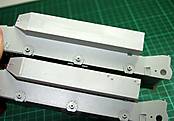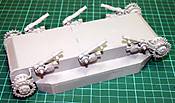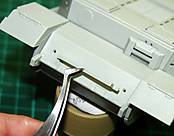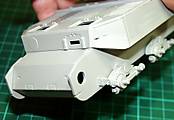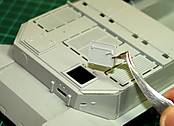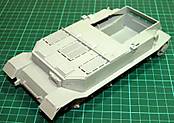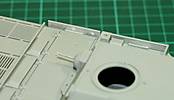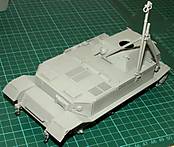1⁄35Bergepanzer Tiger (P) Build Story
Introduction
This latest kit from Dragon depicts an example of the Bergpanzer Tiger (P), this was based on the Porsche design for the Tiger, and although eventually not used, the Henschel design that was eventually to become the Tiger 1 did use the turret and 8.8cm gun from the Porsche design. This Porsche design eventually was used however, as the basis for the Ferdinand and Elefant, and several of the sprues in this kit are from Dragonsí earlier releases of these kits. The parts, all separately bagged as is the norm from Dragon these days, all exhibit no flash, and hardly any knock-out marks, although there are a few which are in easy to fix locations, Iíll come to these later.
The box contains a huge amount of parts, a large proportion of which will be consigned to the spares box by the end of the build, this is because Dragon seems to have a policy of including the entire sprue from an earlier kit, even if just one part is needed. I really like this, as Iíve said there is plenty for the spares box, and when you open the box, it really makes you feel you are getting your moneysí worth, and I think we are!

Construction
Construction begins with preparing the 12 pairs of wheels plus the drive and idler wheels. I have found on some Dragon kits that the fit of wheel-to-wheel when paired is not that positive. Not so with these, the fir is very positive and it would be difficult not to have them fit squarely together. This stage also deals with the construction of the 6 bogeys, which are beautifully detailed, each one made up of 5 parts. Be careful not to mix up which is which as one on either side does face in the opposite direction to the others on the same side. If you intend cementing the running gear in a fixed position then you will have to be careful, as there is an awful lot of play in the correct positioning of the bogeys, and therefore the wheels themselves. The front drive housings are best left off until the tracks are installed as they are adjustable to allow you to obtain the correct sag in the tracks and there is an awful lot of sag if the drive sprocket is fixed in the wrong position.
The rest of this construction stage deals with preparing the Lower hull to accept the running gear. It is actually the same moulding as that supplied with the Tiger (P) kit and so requires some detail removed, this being four bolt heads either side, and some feint marks for locating parts not required for this kit. Interestingly, the instructions indicate that two holes should be drilled in the glacis plate, with no mention of what they are for. It turns out they are for two towing shackle mounts which are only fitted to the late version. So if you decide to build one of the two early versions offers then do not drill them. I did and had to fill them later. Lastly, the mud scrapers for both idlers and drive sprockets are fitted, and although it looks tight, these can be cemented now, as it is possible to fit the tracks and wheels later with these in place.
Stages 4, 5 & 6Stages 4, 5 & 6 deal with fitting the wheels and tracks to the hull, all of which I left until after painting. Stage 6 also reminds us to remove the bolt head detail removed earlier. Which is nice.
stage 7At stage 7 (blue) the decision has to be made to make either one of the two early versions offered, or one of the two late versions, as the hull deck differs, as does the choice of parts. If you decide to build one of the late versions then you will need to go straight to stage 7 (black). I had decided to build one of the early versions, since neither of these require Zimmerit, nor so continued with the blue instruction stages. Although the same deck is to be used, for the early version four holes have to be drilled, their locations clearly marked, and for the late version the engine slats have to be completely removed, in order to add other parts later. Dragon has made the removal of these easy by only attaching them to the deck with small tabs that can easily be cut through and then the edges cleaned up. The instructions continue with the installation of the track guards, the hull front with the blanked off MG opening, and the rack for the spare tracks on the hull front, the location of which I had to guestimate since there is no indication on the glacis as to where it goes. It would have been nice for Dragon to include some spare links to put in this, but you might have some in your spares box. I didnít, so if they really are spare then you can send them to me! Dragon includes detail on the inside of both driversí and co-driversí hatches, but I had already decided to display these closed.

Stages 11, 12 & 13, which are still blue and therefore referring to the early version deal with the construction of the hull superstructure. The loading/escape hatch on the rear of the superstructure has internal detail, although I had decided to display this closed also. All the parts fit together beautifully, and there is even a photo-etched bracket supplied for the jack in place of the plastic one also supplied. Two really nice metal tow ropes are supplied to be fitted with injection moulded styrene eyelets, although I couldnít really decide where to fit them, and there wasnít anywhere indicated on the instruction sheet, so in the end I left these off. They will come in handy later, just not on this model. I was a little disappointed at this stage that there is quite a large gap underneath the rear of the superstructure that needs blanking off with some styrene sheet, or daylight will be visible when the commandersí hatch is left open.
The stages for the construction of one of the late versions begin here, the main difference being the different engine grid layout, the addition of the MG, some small guard brackets at the front, and of course the Zimmerit anti-magnetic mine paste. There must be nearly as many different ways of simulating this coating, as there are modellers out there. Personally, it is something I have yet to attempt and so I canít really offer any advice if you have not tried it yourself. I think I will hold out until there is a resin sheet from one of the after market firms.
Stage 14Stage 14 is the construction of the all the pulleys and frame for the lifting gear. There are some different options to decide on here. The lifting gear can be shown raised on the left of the vehicle, as I have done. On the right, or stowed on the deck, and there are photo-etched straps for this purpose included in the kit. Again, Dragon has indicated earlier in the instructions that four holes are to be drilled with no indication of what the holes are for. It is only at this later stage that we discover the hole were to be used for locating the stowed lifting gear. So if, like me, you are displaying the lifting gear raised, then it leaves you with the holes to be filled. I decided to cover these holes with the straps that would have held the stowed gear, and so made four small brackets, in two sizes from tin foil and four straps to place in them. The lifting gear is a work of art. Most of it can be made to actually work, after a fashion, which helps with proper alignment later. There are three lengths of chain supplied, of two types, already cut to the required length. I constructed and painted all of these pulleys separately.




